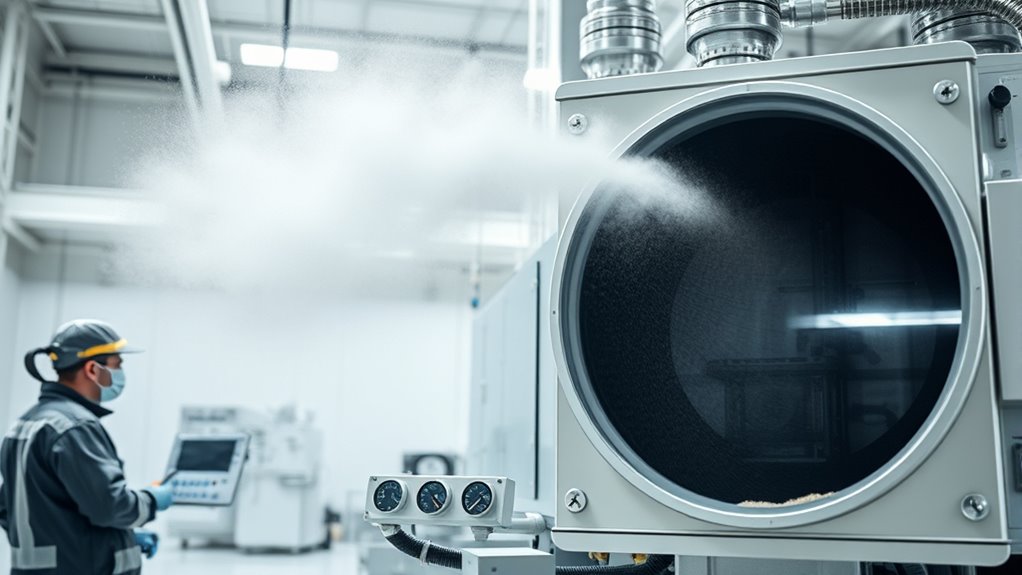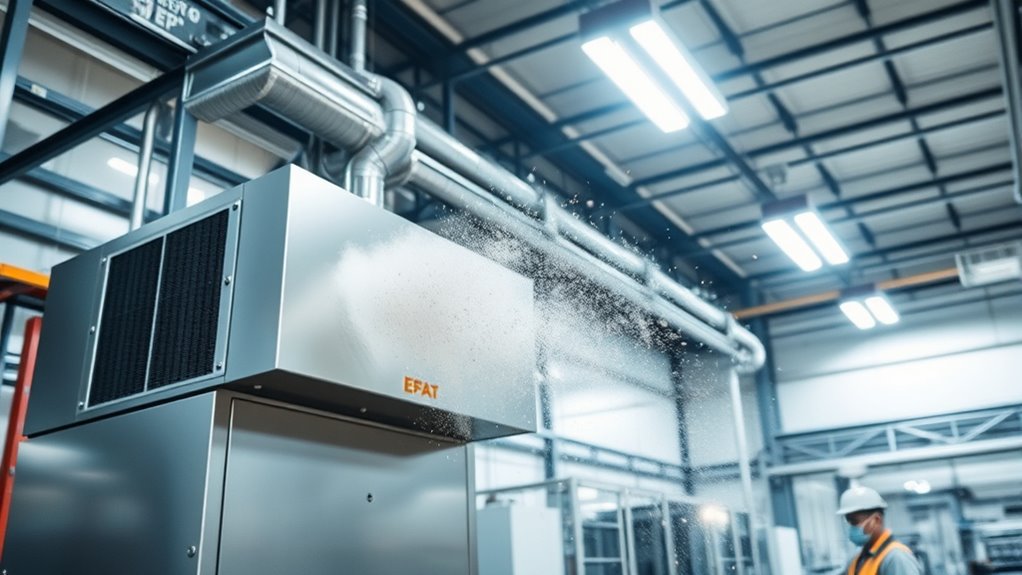Understanding dust control and PM filtration involves knowing how these systems help maintain healthy air quality by capturing airborne particles. You’ll want to focus on different filtration types like baghouse, cartridge, and electrostatic systems, each suited for specific needs. Regular inspection, maintenance, and monitoring ensure best performance and compliance. If you want to learn more about keeping your environment safe and efficient, keep exploring how these systems work and stay effective.
Key Takeaways
- Dust control and PM filtration systems are essential for maintaining healthy air quality in industrial settings.
- Regular maintenance and inspection ensure filters operate efficiently and prevent system failures.
- Different filtration technologies, like baghouse and cartridge filters, are selected based on operational needs.
- Monitoring tools such as sensors and PM monitors help track system performance and air quality.
- Staff training on system use and maintenance optimizes filtration effectiveness and compliance with safety standards.

Dust control and particulate matter (PM) filtration are essential for maintaining healthy air quality in industrial and commercial environments. When you prioritize effective dust management, you’re taking critical steps toward protecting workers, complying with regulations, and ensuring your facilities operate efficiently. Central to this effort is understanding how air quality management intersects with filtration system maintenance. Regular upkeep of your filtration systems guarantees they function at peak performance, capturing harmful particles before they compromise air quality.
Effective dust management relies on regular filtration system maintenance to ensure optimal air quality and safety.
In your day-to-day operations, dust can originate from various sources—cutting, grinding, packaging, or material handling—all of which release PM into the environment. Without proper controls, these particles can accumulate, leading to health issues like respiratory problems or allergies among staff, and even pose fire hazards if fine dust settles on equipment. That’s why implementing a robust dust control plan is fundamental. A key component of this plan involves selecting the right filtration systems tailored to your specific needs, whether it’s baghouse filters, cartridge filters, or electrostatic precipitators. These systems work continuously to trap particles, but their effectiveness depends heavily on ongoing maintenance.
Air quality management isn’t a set-it-and-forget-it process. You need to regularly check and service your filtration systems to prevent clogging, which reduces airflow and filtration efficiency. For example, filters that are overdue for replacement can allow PM to bypass capture, defeating the purpose of your dust control measures. Scheduled filtration system maintenance involves inspecting filters for damage, cleaning or replacing them as needed, and ensuring that the entire ventilation system operates smoothly. This proactive approach minimizes downtime and extends equipment lifespan, all while maintaining a safe work environment.
Additionally, monitoring the particulate levels in your facility provides valuable feedback on your dust control effectiveness. Use air quality sensors or PM monitors to identify if your filtration systems are performing *at their most efficient* or if adjustments are necessary. Proper air quality management also involves training your staff to recognize signs of system failures and understand maintenance routines. When everyone is informed and vigilant, you’re better equipped to catch issues early and prevent costly repairs or regulatory violations. Incorporating regular filter inspections is crucial because it helps maintain optimal filtration performance and ensures compliance with health standards.
Frequently Asked Questions
How Often Should Dust Filtration Systems Be Maintained?
You should maintain your dust filtration systems according to a regular maintenance schedule, typically every 3 to 6 months, depending on use and environment. Regular inspections help identify when filter replacement is necessary to guarantee peak performance. Keep an eye on pressure gauges and airflow; if they indicate a decline, it’s time for filter replacement. Consistent maintenance keeps your system efficient, reduces downtime, and maintains a safe, clean workspace.
What Are the Environmental Impacts of Improper Dust Control?
When you neglect proper dust control, you negatively impact air quality and increase health risks for workers and nearby communities. Dust particles can carry harmful contaminants, leading to respiratory issues, allergies, and long-term health problems. Environmental impacts include air pollution and potential contamination of soil and water sources. To protect health and the environment, you should guarantee effective dust management practices and regular maintenance of filtration systems.
Can Portable Dust Extractors Be Used for Large-Scale Operations?
Yes, you can use portable dust extractors for large-scale operations, but they have limitations. Portable extractors are ideal for smaller or localized tasks, offering flexibility and ease of use. For large-scale filtration, you’ll need industrial-grade systems designed specifically for high-volume dust control. These larger systems provide more effective containment and filtration, ensuring safety and compliance while addressing the demands of extensive operations.
What Are the Cost Differences Between Various PM Filtration Systems?
You’ll find that costs vary based on filtering efficiency and installation expenses. Higher-efficiency systems usually cost more upfront but save money long-term through better dust control. Portable systems tend to be less expensive than fixed ones, which require extensive installation. Consider your operation’s size and dust levels to balance initial costs with ongoing maintenance. Investing in a system with ideal filtering efficiency ensures healthier air and reduces long-term costs.
How Do Weather Conditions Affect Dust Control Effectiveness?
Weather variability and humidity effects considerably impact dust control effectiveness. When humidity levels rise, dust particles tend to clump together, making filtration easier and more efficient. Conversely, dry, windy conditions can disperse dust more widely, reducing filtration efficiency. You should monitor weather forecasts closely, adjusting dust control measures accordingly. Implementing additional controls during dry, windy days helps guarantee consistent dust suppression, protecting your environment and maintaining compliance.
Conclusion
Remember, a clean environment is a safe environment. By implementing effective dust control and PM filtration, you’re not only protecting your health and that of others but also ensuring your workspace stays compliant and efficient. Don’t wait until dust becomes a problem—stay proactive. As the saying goes, “An ounce of prevention is worth a pound of cure.” Keep dust in check now, and you’ll thank yourself later for a healthier, safer space.








